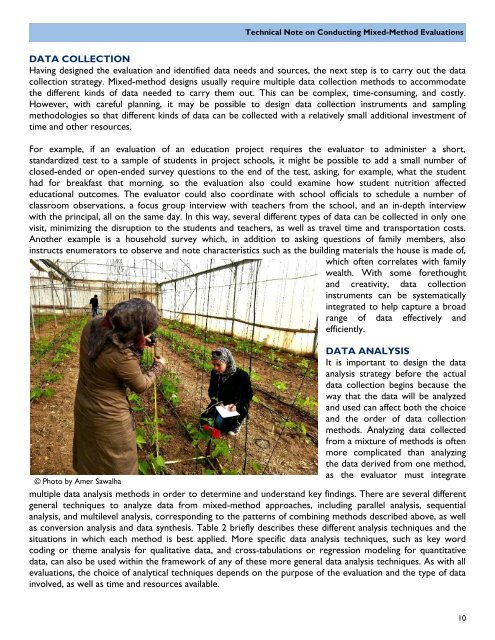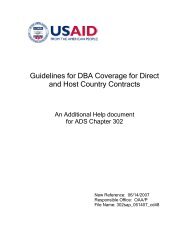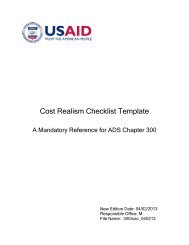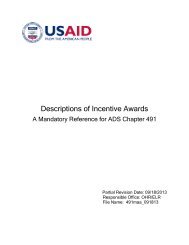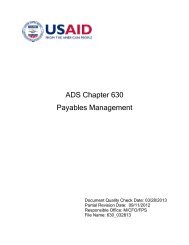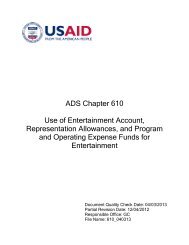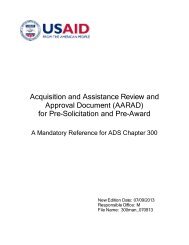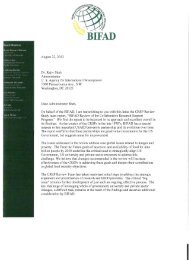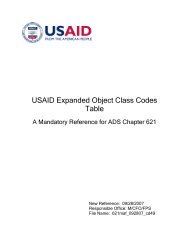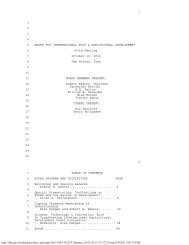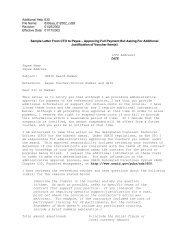Technical Note: Conducting Mixed Method Evaluations - usaid
Technical Note: Conducting Mixed Method Evaluations - usaid
Technical Note: Conducting Mixed Method Evaluations - usaid
You also want an ePaper? Increase the reach of your titles
YUMPU automatically turns print PDFs into web optimized ePapers that Google loves.
<strong>Technical</strong> <strong>Note</strong> on <strong>Conducting</strong> <strong>Mixed</strong>-<strong>Method</strong> <strong>Evaluations</strong><br />
DATA COLLECTION<br />
Having designed the evaluation and identified data needs and sources, the next step is to carry out the data<br />
collection strategy. <strong>Mixed</strong>-method designs usually require multiple data collection methods to accommodate<br />
the different kinds of data needed to carry them out. This can be complex, time-consuming, and costly.<br />
However, with careful planning, it may be possible to design data collection instruments and sampling<br />
methodologies so that different kinds of data can be collected with a relatively small additional investment of<br />
time and other resources.<br />
For example, if an evaluation of an education project requires the evaluator to administer a short,<br />
standardized test to a sample of students in project schools, it might be possible to add a small number of<br />
closed-ended or open-ended survey questions to the end of the test, asking, for example, what the student<br />
had for breakfast that morning, so the evaluation also could examine how student nutrition affected<br />
educational outcomes. The evaluator could also coordinate with school officials to schedule a number of<br />
classroom observations, a focus group interview with teachers from the school, and an in-depth interview<br />
with the principal, all on the same day. In this way, several different types of data can be collected in only one<br />
visit, minimizing the disruption to the students and teachers, as well as travel time and transportation costs.<br />
Another example is a household survey which, in addition to asking questions of family members, also<br />
instructs enumerators to observe and note characteristics such as the building materials the house is made of,<br />
which often correlates with family<br />
wealth. With some forethought<br />
and creativity, data collection<br />
instruments can be systematically<br />
integrated to help capture a broad<br />
range of data effectively and<br />
efficiently.<br />
© Photo by Amer Sawalha<br />
DATA ANALYSIS<br />
It is important to design the data<br />
analysis strategy before the actual<br />
data collection begins because the<br />
way that the data will be analyzed<br />
and used can affect both the choice<br />
and the order of data collection<br />
methods. Analyzing data collected<br />
from a mixture of methods is often<br />
more complicated than analyzing<br />
the data derived from one method,<br />
as the evaluator must integrate<br />
multiple data analysis methods in order to determine and understand key findings. There are several different<br />
general techniques to analyze data from mixed-method approaches, including parallel analysis, sequential<br />
analysis, and multilevel analysis, corresponding to the patterns of combining methods described above, as well<br />
as conversion analysis and data synthesis. Table 2 briefly describes these different analysis techniques and the<br />
situations in which each method is best applied. More specific data analysis techniques, such as key word<br />
coding or theme analysis for qualitative data, and cross-tabulations or regression modeling for quantitative<br />
data, can also be used within the framework of any of these more general data analysis techniques. As with all<br />
evaluations, the choice of analytical techniques depends on the purpose of the evaluation and the type of data<br />
involved, as well as time and resources available.<br />
10


